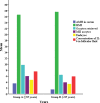IL-6 of follicular fluid and outcome of in vitro fertilization
- PMID: 35866786
- PMCID: PMC9302246
- DOI: 10.1097/MD.0000000000029624
IL-6 of follicular fluid and outcome of in vitro fertilization
Abstract
The quality of an oocyte is influenced by its microenvironment, which includes cumulus cells and follicular fluid, as well as cells of the immune system and their products. The ovarian interleukins, which are secreted by the granulosa cells and other immune cells within the ovaries and follicles, regulate various functions between the cells. IL-6 is a cytokine that is present in the follicular fluid and may affect the quality of oocytes. There are some inconsistencies in the literature regarding the concentration of interleukin 6 in the follicular fluid. The main objective of this study was to examine whether the concentration of interleukin 6 in the follicular fluid affects the outcome of IVF. This study involved 83 patients who underwent IVF. Follicular fluid was used as the biological material for the analysis. Examination of the obtained follicular fluid and collection of oocytes under a stereomicroscope was performed in the embryological laboratory. The concentration of IL-6 in the follicular fluid was analyzed. IVF and ICSI methods were used as the fertilization methods. Pregnancy was confirmed by the positive serum β-hCG level. The software package SPSS 20 was used for statistical data processing. Analysis of the follicular fluid samples showed a correlation between the concentration of IL-6 in the follicular fluid and the outcome of IVF. The concentration of IL-6 in the follicular fluid was higher in patients with confirmed pregnancy (9.55 ± 7.47 ng/ml). Based on our results, we conclude that the concentration of IL-6 affects the outcome of IVF. If the range of IL-6 concentration is between 3,67 ng/ml and 10 ng/ml, we can expect good IVF outcome with vital pregnancy.
Copyright © 2022 the Author(s). Published by Wolters Kluwer Health, Inc.
Conflict of interest statement
Authors declare that they have no conflict of interests.
Figures




Similar articles
-
Activity of enzymes in the follicular fluid and outcome of in vitro fertilization.Medicine (Baltimore). 2024 Jan 26;103(4):e36851. doi: 10.1097/MD.0000000000036851. Medicine (Baltimore). 2024. PMID: 38277545 Free PMC article.
-
Cell-free DNA in human follicular fluid as a biomarker of embryo quality.Hum Reprod. 2014 Dec;29(12):2661-9. doi: 10.1093/humrep/deu238. Epub 2014 Sep 29. Hum Reprod. 2014. PMID: 25267787
-
Presence of bile acids in human follicular fluid and their relation with embryo development in modified natural cycle IVF.Hum Reprod. 2015 May;30(5):1102-9. doi: 10.1093/humrep/dev034. Epub 2015 Mar 8. Hum Reprod. 2015. PMID: 25753582
-
Follicular fluid progesterone concentration is associated with fertilization outcome after IVF: a systematic review and meta-analysis.Reprod Biomed Online. 2019 Jun;38(6):871-882. doi: 10.1016/j.rbmo.2018.12.045. Epub 2019 Jan 17. Reprod Biomed Online. 2019. PMID: 30948305
-
The pathophysiology of endometriosis-associated infertility: follicular environment and embryo quality.J Reprod Fertil Suppl. 2000;55:109-19. J Reprod Fertil Suppl. 2000. PMID: 10889840 Review.
Cited by
-
Associations Between Follicular Fluid Biomarkers and IVF/ICSI Outcomes in Normo-Ovulatory Women-A Systematic Review.Biomolecules. 2025 Mar 20;15(3):443. doi: 10.3390/biom15030443. Biomolecules. 2025. PMID: 40149979 Free PMC article.
-
An Approach to Improve Endometrial Receptivity: Is It Beneficial to Flush The Uterine Cavity with Follicular Fluid and Granulosa Cells? A Phase III Randomised Clinical Trial.Int J Fertil Steril. 2024 Jul 13;18(Suppl 1):22-29. doi: 10.22074/ijfs.2023.2000897.1461. Int J Fertil Steril. 2024. PMID: 39033367 Free PMC article.
-
Oxidative Stress-Related Signaling Pathways Predict Oocytes' Fertilization In Vitro and Embryo Quality.Int J Mol Sci. 2022 Nov 3;23(21):13442. doi: 10.3390/ijms232113442. Int J Mol Sci. 2022. PMID: 36362229 Free PMC article.
-
Altered Immune Cell Profiles in the Follicular Fluid of Patients with Poor Ovarian Response According to the POSEIDON Criteria.J Inflamm Res. 2024 Dec 8;17:10663-10679. doi: 10.2147/JIR.S473068. eCollection 2024. J Inflamm Res. 2024. PMID: 39677298 Free PMC article.
-
Ovarian microenvironment: challenges and opportunities in protecting against chemotherapy-associated ovarian damage.Hum Reprod Update. 2024 Oct 1;30(5):614-647. doi: 10.1093/humupd/dmae020. Hum Reprod Update. 2024. PMID: 38942605 Free PMC article. Review.
References
-
- Lu H, Huang Y, Xin H, et al. . The expression of cytokines IFN-γ, IL-4, IL-17A, and TGF-β1 in peripheral blood and follicular fluid of patients testing positive for anti-thyroid autoantibodies and its influence on in vitro fertilization and embryo transfer pregnancy outcomes. Gynecol Endocrinol. 2018;34:933–9. - PubMed
-
- Prince JR, Marissen LM, Scherjon SA, et al. . Is there an immune modulating role for follicular fluid in endometriosis? a narrative review. Reproduction. 2020;159:45–54. - PubMed
-
- Yogesh K, Saumya P, Syed A, et al. . Follicular Fluid IL-6 levels in prediction of successful pregnancy outcome in women undergoing IVF-ET cycles - a prospective Study. Int J Sci Res. 2016;5:1724–32.
MeSH terms
Substances
LinkOut - more resources
Full Text Sources

